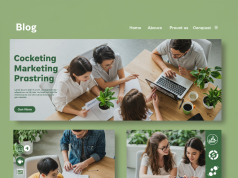Deciding on the right marketing strategy can feel like a high-stakes choice. Should you go out and find your customers, or should you create a space where they can find you? This is the central question in the debate between outbound and inbound marketing. While both approaches aim for the same goal—business growth—they take fundamentally different paths to get there.
Outbound marketing is the traditional method we’re all familiar with. It involves actively pushing a message out to a broad audience through channels like TV commercials, cold calls, and print ads. Think of it as marketing to people. Inbound marketing, on the other hand, is a newer approach that focuses on attracting customers by creating valuable content and experiences tailored to them. It’s about drawing people in with blogs, social media, and SEO, effectively marketing to people.
Understanding the nuances, costs, and potential returns of each strategy is crucial for any business looking to spend its marketing budget wisely. This guide will break down the key differences between inbound and outbound marketing, explore their respective pros and cons, and help you determine which approach, or combination of both, will best serve your unique business goals.
What Is Inbound Marketing?

Inbound marketing is a strategic approach centered on attracting customers by creating valuable content and experiences they actively seek out. Instead of interrupting potential customers, inbound marketing aims to pull them in by providing solutions to their problems and answering their questions. The goal is to build trust and credibility, establishing your brand as a helpful authority in your industry. Learn more about inbound marketing.
The inbound methodology follows the customer through their entire journey, from stranger to delighted promoter. This process is often visualized in three stages:
- Attract: Drawing in the right people with valuable content that establishes you as a trusted advisor. This is achieved through blog posts, social media content, and search engine optimization (SEO).
- Engage: Presenting insights and solutions that align with their pain points and goals. This involves interacting through email marketing, lead forms, and chatbots.
- Delight: Providing help and support to empower your customers to find success with their purchase. This includes surveys, exceptional customer service, and community engagement.
By focusing on building relationships, inbound marketing creates a sustainable and cost-effective engine for long-term growth.
The Benefits of Inbound Marketing
- Cost-Effective: Inbound marketing often has a lower cost-per-lead compared to outbound methods. Creating a blog post or social media content can continue to attract leads for years, providing a high return on the initial investment.
- Builds Trust and Credibility: By offering valuable information without asking for anything in return, you build a foundation of trust with your audience. When they are ready to buy, they are more likely to choose the brand that has consistently helped them.
- Higher Quality Leads: Since inbound marketing attracts people who are already searching for solutions, the leads generated are often more qualified and engaged. They have a genuine interest in your product or service, leading to shorter sales cycles and higher conversion rates.
- Long-Term Asset Creation: Every piece of content you create—be it a blog post, a YouTube video, or a podcast episode—becomes a long-term asset for your business. This content works for you 24/7, continuously drawing in traffic and leads over time.
The Drawbacks of Inbound Marketing
- Time-Consuming: Inbound marketing is not a quick fix. It takes significant time and consistent effort to create high-quality content, build an audience, and see substantial results. It can be months before your SEO efforts start paying off.
- Requires Diverse Skills: A successful inbound strategy requires expertise in various areas, including content writing, SEO, social media management, and data analysis. Small teams may find it challenging to cover all these bases effectively.
What Is Outbound Marketing?
Outbound marketing, often called “traditional” or “interruption” marketing, involves proactively reaching out to potential customers to get your message in front of them. This strategy relies on pushing a message to a wide audience, regardless of whether they have expressed interest in your product or service.
Think of the classic marketing channels: television and radio commercials, telemarketing calls, direct mail, trade show booths, and print advertisements in newspapers or magazines. In the digital realm, outbound marketing includes display ads, email blasts to purchased lists, and pop-up ads. The core idea is to initiate the conversation and broadcast your message as widely as possible in the hope of capturing the attention of a fraction of the audience.
While sometimes viewed as outdated, outbound marketing can still be effective for specific goals, such as building broad brand awareness quickly or reaching demographics that are less active online.
The Benefits of Outbound Marketing
- Generates Quick Results: If you need to generate awareness or leads quickly, outbound marketing can deliver. A well-placed ad campaign can put your brand in front of thousands or even millions of people in a very short amount of time.
- Broad Reach: Outbound tactics are excellent for building widespread brand recognition. TV ads, billboards, and other mass-media channels can make your brand a household name within a specific geographic area.
- Clear Targeting for Certain Demographics: For businesses targeting older audiences or those less engaged with digital media, traditional outbound channels like print, direct mail, or television can be highly effective.
The Drawbacks of Outbound Marketing
- High Cost: Outbound marketing is generally expensive. Buying ad space on TV, radio, or in major publications requires a significant budget, and the cost-per-lead can be much higher than with inbound methods.
- Lower Engagement and ROI: Because outbound marketing is interruptive, many people have learned to tune it out. Ad blockers are common online, and people often change the channel during commercial breaks. This leads to lower engagement rates and a less predictable return on investment.
- Difficulty in Tracking: It can be challenging to measure the direct impact of many outbound campaigns. While you can track how many people saw a billboard, it’s difficult to know how many of them became customers as a direct result.
Inbound vs. Outbound: A Head-to-Head Comparison
|
Feature |
Inbound Marketing |
Outbound Marketing |
|---|---|---|
|
Approach |
Pulls customers in |
Pushes messages out |
|
Communication |
Two-way, interactive |
One-way, broadcast |
|
Focus |
Building relationships, providing value |
Generating sales, brand awareness |
|
Cost |
Lower cost-per-lead, long-term investment |
Higher upfront cost |
|
ROI |
Generally higher and more sustainable |
Often lower and harder to track |
|
Lead Quality |
High-quality, engaged leads |
Variable quality, often unqualified |
|
Time to Results |
Slower, builds momentum over time |
Faster, provides immediate visibility |
|
Key Channels |
SEO, blogs, social media, email marketing |
TV/radio ads, cold calls, direct mail |
The Best Strategy: Combining Inbound and Outbound
The debate shouldn’t be about choosing inbound or outbound marketing. The most powerful strategies often integrate elements of both to create a comprehensive marketing plan. This hybrid approach, sometimes called “all-bound” marketing, allows businesses to leverage the strengths of each methodology while mitigating their weaknesses.
Here’s how you can make them work together:
- Use Outbound to Fuel Inbound: Run a targeted social media ad campaign (outbound) to promote a valuable piece of content, like an in-depth ebook or a free webinar (inbound). The ads generate immediate traffic, while the content captures leads and nurtures them over time.
- Amplify Your Content: After publishing a fantastic blog post, use outbound tactics like a paid social campaign or a feature in an industry newsletter to ensure it reaches a wider audience than your organic reach alone would allow.
- Follow Up on Outbound Leads with Inbound Nurturing: If you collect leads at a trade show (outbound), enroll them in a targeted email nurture sequence (inbound) that provides valuable content related to their interests and pain points.
By combining the immediate reach of outbound with the long-term, relationship-building power of inbound, you create a more resilient and effective marketing engine.
Choosing the Right Path for Your Business

So, is inbound marketing better than outbound marketing? For most modern businesses looking for sustainable growth, high-quality leads, and a strong ROI, inbound marketing is the superior long-term strategy. It builds assets that generate value for years and fosters genuine customer relationships.
However, that doesn’t render outbound marketing obsolete. Outbound tactics still have a valuable role to play, especially for businesses needing to build brand awareness quickly or for those targeting specific offline demographics.
Ultimately, the best approach depends on your specific goals, budget, industry, and target audience. Start by building a strong inbound foundation. Create valuable content that solves your audience’s problems and optimize your online presence. Then, strategically layer in outbound tactics to amplify your message and accelerate your results. In doing so, you’ll get the best of both worlds and build a marketing strategy that drives predictable, long-term growth.




